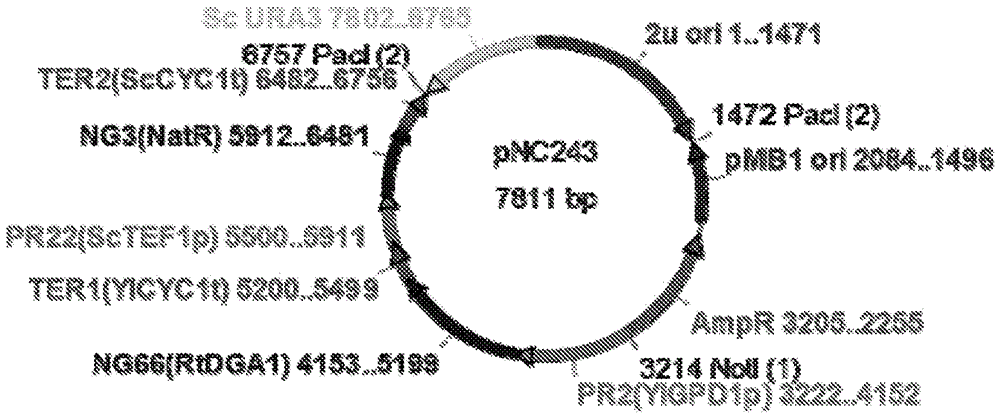Increasing cellular lipid production by increasingthe activity of diacylglycerol acyltransferase and decreasing the activity of triacylglycerol lipase
A technology of diacylglycerol acyl and triacylglycerol, applied in the directions of acyltransferase, transferase, introduction of foreign genetic material using a carrier, etc., can solve problems such as unreported lipid yield level
- Summary
- Abstract
- Description
- Claims
- Application Information
AI Technical Summary
Problems solved by technology
Method used
Image
Examples
Embodiment 1
[0171] Example 1: Method for overexpressing DGA1 in Yarrowia lipolytica
[0172] Nucleic acid constructs for overexpressing the DGA1 gene are described in USSN 61 / 943,664 (incorporated herein by reference). figure 1 Expression construct pNC243 for overexpression of Rhodosporidium toruloides DGA1 gene NG66 (SEQ ID No. 6) in Yarrowia lipolytica is shown. The DGA1 expression construct was linearized by PacI / NotI restriction enzyme digestion prior to transformation. The linear expression constructs each contained expression cassettes for the DGA1 gene and the Nat1 gene, used as markers for nourthricin (NAT) selection.
[0173] Using such as Chen (Applied Microbiology & Biotechnology 48 : 232-35 (1997)) randomly integrated the DGA1 expression construct into the genome of Yarrowia lipolytica strain NS18 (obtained from the ARS Culture Collection, NRRL# YB 392). Transformants were selected on YPD plates containing 500 µg / mL NAT and screened for their ability to accumulate lipi...
Embodiment 2
[0178] Example 2: Method for knocking out triacylglycerol lipase knockout gene in Yarrowia lipolytica
[0179] To test the idea that DGA1 overexpression combined with TGL3 deletion resulted in higher lipid accumulation in Y. TGL3 is missing in the DGA1 derivative NS281. NS281 overexpresses the DGA1 gene from Rhodosporidium toruloides as described above. as follows, missing Yarrowia lipolytica TGL3 Gene (YALI0D17534g, SEQ ID NO: 20): by PCR from the hygromycin resistance gene (" hph , "SEQ ID NO: 22) plasmid amplified two-segment deletion cassette using the primer pair NP1798-NP656 and NP655-NP1799 (SEQ ID NO: 23-26). According to the protocol developed in USSN 61 / 819,746 (by reference incorporated herein), the resulting PCR fragment (SEQ ID NO: 27 & 28) was co-transformed into NS18 and NS281. In hph The promoter and terminator are omitted from the cassette and the hph Splitting the coding sequence into two PCR fragments reduces the likelihood that random integrati...
Embodiment 3
[0180] Example 3: TGL3 knockouts overexpressing DGA1 accumulate more lipids than TGL3 knockouts alone
[0181] to contain TGL3 Knockout of NS421 and containing TGL3 NS377 deletion and simultaneous overexpression of Rhodosporidium toruloides DGA1 were grown in 24-well plates under nitrogen-limited conditions to promote lipid accumulation.
[0182] Specifically, 1.5 mL of 0.5 g / L urea, 1.5 g / L yeast extract, 0.85 g / L casamino acid, 1.7 g / L Filter-sterilized medium of YNB (without amino acids and ammonium sulfate), 100 g / L glucose, and 5.11 g / L potassium hydrogen phthalate (25 mM). Each well was inoculated with a yeast strain that had been incubated on YPD agar plates at 30°C for 1-2 days. The 24-well plate was covered with a perforated lid and incubated on an Infors Multitron ATR shaker at 30°C, 70-90% humidity, and 900 rpm. After 96 hours, add 20 μL of 100% ethanol to 20 μL of cells on an analytical microplate and incubate at 4 °C for 30 min. Then, in a Costar 96-wel...
PUM
 Login to View More
Login to View More Abstract
Description
Claims
Application Information
 Login to View More
Login to View More - R&D Engineer
- R&D Manager
- IP Professional
- Industry Leading Data Capabilities
- Powerful AI technology
- Patent DNA Extraction
Browse by: Latest US Patents, China's latest patents, Technical Efficacy Thesaurus, Application Domain, Technology Topic, Popular Technical Reports.
© 2024 PatSnap. All rights reserved.Legal|Privacy policy|Modern Slavery Act Transparency Statement|Sitemap|About US| Contact US: help@patsnap.com










